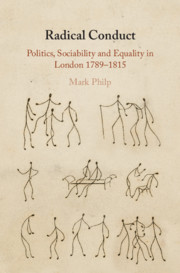Book contents
- Radical Conduct
- Radical Conduct
- Copyright page
- Dedication
- Contents
- Figures and Tables
- Acknowledgements
- Introduction
- 1 Politics and Privacy
- 2 Disagreement and Deliberation
- 3 Plurality
- 4 Radical Literary Women
- 5 Gender and Deliberative Equality
- 6 Negotiating Equality
- 7 A Private Affair
- 8 Music and Movement
- Conclusion
- Bibliography
- Index
2 - Disagreement and Deliberation
Published online by Cambridge University Press: 20 August 2020
- Radical Conduct
- Radical Conduct
- Copyright page
- Dedication
- Contents
- Figures and Tables
- Acknowledgements
- Introduction
- 1 Politics and Privacy
- 2 Disagreement and Deliberation
- 3 Plurality
- 4 Radical Literary Women
- 5 Gender and Deliberative Equality
- 6 Negotiating Equality
- 7 A Private Affair
- 8 Music and Movement
- Conclusion
- Bibliography
- Index
Summary
How did people understand those with whom they disagreed? How was that disagreement handled?And how was that process affected by the heightened political climate of the 1790s? More especially, how did literary radicals such as Godwin, who believed in the communicability of truth, understand his developing disagreements with a range of men who, by the end of the decade, were willing to denounce his ideas from the lectern and pulpit? This chapter charts the breakdown of several of Godwin’s friendships, including Samul Parr, James Mackintosh and Francis Burdett, and looks at the wider problems faced for his understanding of his deliberative aspirations as repression and financial hardship increasingly undermined the social world he had been able to take for granted earlier in the decade.It also looks at evidence of decreasing confidence among radicals, and others, in the light of this reaction and the intrusion of loyalism into people’s sense of their private concerns.
- Type
- Chapter
- Information
- Radical ConductPolitics, Sociability and Equality in London 1789-1815, pp. 57 - 92Publisher: Cambridge University PressPrint publication year: 2020

